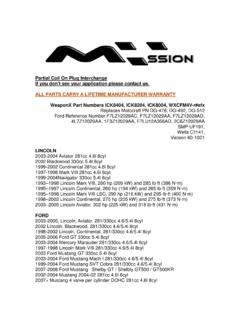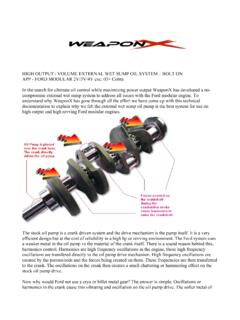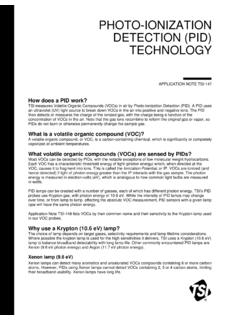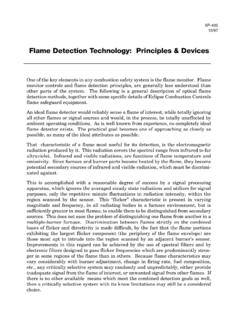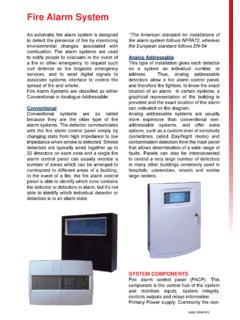Transcription of SPARK CENTER ELECTRODE and TIP DESIGN
1 SPARK PLUG TECHNICAL INFORMATION (WHITEPAPER) SPARK CENTER ELECTRODE and TIP DESIGN The performance tuning industry is brimming with misinformation regarding SPARK plug CENTER ELECTRODE DESIGN , with perhaps the largest misconception of all being that because copper is a better conductor than iridium the so-called copper SPARK plugs offered by many manufacturers are also somehow superior. It is true that copper is superior to iridium in its heat and electrical conduction capabilities, however it is also a completely unsuitable material to be used as a high voltage ELECTRODE , and it not used as ELECTRODE material on any SPARK plug. The so-called copper plugs often spoken about use copper plugged nickel/chrome alloy for the CENTER ELECTRODE . Perhaps contrary to intuitive thinking, in SPARK plug DESIGN the conduction of electricity is of secondary concern to minimizing the power needed to ionize the SPARK gap. This is because ionization of the gap requires the largest amount of the total electrical energy supplied to the plug this is known as the gap breakdown voltage.
2 Also, from the perspective of lighting an engine fuel charge, this is wasted energy, which if reduced could instead be used to sustain the SPARK for a longer period, improving ignition and combustion. In the quest to minimize breakdown voltage, a smaller CENTER ELECTRODE generally makes a better performing SPARK plug as it requires less voltage to fire than a larger ELECTRODE . However there are many other considerations in the development of tip size. Finding a well balanced tip DESIGN is fundamental for creating a SPARK plug that has a long, high performance service life. For example, an iridium CENTER ELECTRODE with a very small diameter will prove to deteriorate very rapidly. Testing has also shown that it is as tip diameter reaches acceptable, yet not optimal tip life can be achieved. Iridium tips of to diameter have been shown to provide the best long term operation. In this documentation WeaponX has recorded how they determined the optimal tip size for their 360 laser welded iridium SPARK plug.
3 THE EVENTS Figure 1 Figure 1 displays an oscilloscope trace of a typical SPARK plug firing event; from ionization of the gap (the large voltage spike on the left), to the actual SPARK duration (the horizontal plateau between the green markers), to the end of the SPARK and the dissipation of any power remaining in the coil (the ringing at the right end of the trace. Note that it is the ionization event that requires the most voltage, 7 to 10 times or more than the actual SPARK . VOLTAGE REQUIREMENTS Figure 2 Figure 2 shows that in back to back comparisons of , , and CENTER ELECTRODE tips the voltage required to ionize the gaps are nearly identical. Also shown is that when the ELECTRODE diameter is increased to , a size typical of a conventional nickel/chrome alloy CENTER ELECTRODE plug the ionization voltage requirement increases significantly, even at gaps as small as ( ). Electrons prefer to jump from a smaller and/or pointed ELECTRODE , and while it would be easiest to pull electrons from a sharp pointed ELECTRODE , a sharp pointed ELECTRODE of any material used in an internal combustion engine ignition system would erode after only a few seconds, and therefore be quite impractical.)
4 Instead SPARK plugs use square ended electrodes, and the electrons that initialize ionization of the gap are emitted from the sharp edges at the circumference of the ELECTRODE s end. These edges erode as would a sharp point, just more slowly, with precious metal electrodes eroding much more slowly than conventional nickel/chrome designs. As the edges wear the SPARK becomes weaker and less reliable. We have seen the desirability of a smaller CENTER ELECTRODE however conventional nickel/chrome electrodes simply cannot be made smaller because of their poor resistance to erosion. So which SPARK plug DESIGN , small or large diameter CENTER ELECTRODE , would be considered superior? The iridium DESIGN wins in 2 areas: 1. the ELECTRODE can be made smaller because of its superior erosion resistance; 2. because of this the gap ionization voltage requirement for iridium is much less; PERFORMANCE THROUGHOUT THE SERVICE LIFE Service life is also affected by erosion of the ground strap (side ELECTRODE ), Figure 3 below shows the results of tests performed using a high power ignition system.
5 Note that with the CENTER ELECTRODE , used by many manufacturers of iridium SPARK plugs , ground strap degradation rapidly increases as there is not enough surface area on the tip to equally distribute the SPARK along the ground strap. This causes rapid deterioration of a small area closest to the SPARK CENTER ELECTRODE . In turn this causes accelerated degradation of SPARK output and soon misfire events, engine horsepower loss and compromised gas mileage follow. PERFORMANCE VS. SERVICE LIFE Figure 3 Using a or CENTER ELECTRODE such rapid deterioration is not as much an issue, because the SPARK plug CENTER ELECTRODE has sufficient outer diameter for a long life span with a high quality SPARK output. Even after 400 hours of use both the and tips are providing a more accurate and intense SPARK than the after only 200 hours. Shown at the right is a comparison of side ELECTRODE erosion caused by and ELECTRODE diameters. The advantage is obvious; the tip offers the best of both worlds.
6 Iridium electrodes are over 2000 times harder then conventional electrodes, permitting production of high temperature electrodes using smaller CENTER wire, and having sharper edges that will not melt or erode. The smaller ELECTRODE also absorbs less heat from the SPARK and initial flame energy, allowing further enhanced output. Iridium DESIGN plugs outperform conventional copper-core plug designs and provide over 60,000 miles of use. IGNITABILITY POTENTIAL Ignitability is a measure of how effectively and efficiently a SPARK plug can ignite a compressed air/fuel mixture, in the combustion chamber. It is best measured by leaning out the air/fuel mixture until misfire occurs, this because lean mixtures are more difficult to ignite. This test provides engineers an indication of which SPARK tip styles will produce better overall ignition characteristics, and DESIGN SPARK plugs that perform better in normal operation, with the end result being more power, lower emissions, and higher overall efficiency of the ignition system.
7 SPARK plugs with a smaller CENTER ELECTRODE diameters offer better ignitability results. The standard SPARK plug CENTER ELECTRODE of diameter, needed with nickel/chrome designs, has 25 times the area at its tip than that of a fine wire ELECTRODE . You can see in the chart below that a conventional ELECTRODE starts to have ignitability problems at air/fuel ratios of 15:1, whereas the fine wire plug can light off mixtures at 17:1 and leaner (Figure 3) IGNITIBILITY Figure 4 During testing, the limits to improving ignitability using a reduction in CENTER ELECTRODE diameter were found to be finite, you can see in Figure 4 that the ignitability curve flattens as the tip diameters falls below This means that using a or finer ELECTRODE would yield little additional performance, and be less resistant to the tip and side ELECTRODE deterioration, and erosion, issues previously presented. It was at this point WeaponX engineers determined this negligible improvement in ignitability did not compensate for the loss of performance throughout a SPARK plug s service life making the fine wire ELECTRODE unquestionably superior to all others.
8 WEAPONX IMPROVING IGNITABILITY BEYOND ELECTRODE DESIGNS The easier it is for fuel and air to make it to the SPARK kernel the better the combustion event, however the more the CENTER ELECTRODE tip is shrouded, the more difficult it is for the SPARK to light off the fuel air mixture. Also, a more open the area around the SPARK kernel offers greater ability for the flame front to propagate. The faster the flame front propagates, the more complete the combustion and the more engine power generated. Through the use of our exclusive CB insulator we have been able to surpass the ignitability potential of a ELECTRODE DESIGN , even though WeaponX uses a fine wire iridium ELECTRODE bringing ignitability potential to the next level. WeaponX's advanced DESIGN provides a iridium fine wire ELECTRODE that actually surpasses the ignitability of a ELECTRODE ; while still offering a long, high performance service life. (see FIGs A and B below) In FIG A you can see the tip DESIGN of leading competitor s SPARK plugs vs the WeaponX SPARK plug.
9 The WeaponX is designed with a drawn back porcelain insulator which opens a larger area to the air/fuel charge that greatly increases ignitibility and also allows for faster flame front propagation. In FIG B you can see that the initial flame front on the WeaponX SPARK plug grows faster and more intensely than the competitor SPARK plugs (yellow indicates competitor flame front size vs the WeaponX flame front). GROUND ELECTRODE DESIGN FURTHER INCREASING IGNITABILITY The ground ELECTRODE strap is an additional key area of SPARK plug development. Some manufacturers offer a U-groove side ELECTRODE DESIGN , and while an interesting concept, the actual increase in area for flame front propagation achieved by slotting the ground strap does not justify the U-groove vs. WeaponX's exclusive porcelain cutback DESIGN . In fact, the U-groove reduces service life of the SPARK plug dramatically (see FIG C). There is more rapid deterioration of the U-grooved ELECTRODE since the removal of material from machining the groove weakens the ELECTRODE s resistance to erosion.
10 Over time the U-groove DESIGN ELECTRODE deteriorates, and so does the overall performance of the SPARK plug. Tapered style ground electrodes erode less and over time offer longer service life and performance. Additionally, note that the SPARK prefers to jump to the outer edges of the ground strap (FIG B). With the-U grooved plug the SPARK prefers to jump to the inner edges of the groove, further shrouding the SPARK kernel and flame front. WeaponX's narrow tapered side ELECTRODE increases flame front propagation and ignitability, while still allowing a long and high performance service life. OTHER PERFORMANCE ENHANCEMENTS AND IGNITABILITY Lowered Internal Resistance WeaponX has designed the ExtremeX and SuperX SPARK plugs with high output in mind and as WeaponX SPARK plugs are classified differently from our competitor s we are freed from Federal Communication Commission (FCC) requirements for electrical and radio frequency noise emissions.
